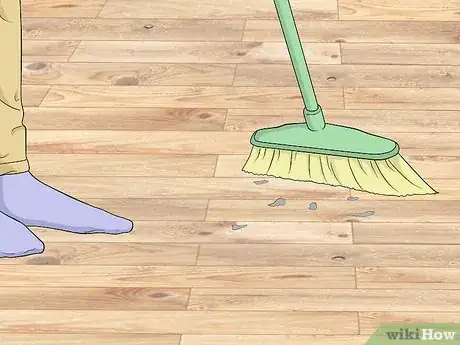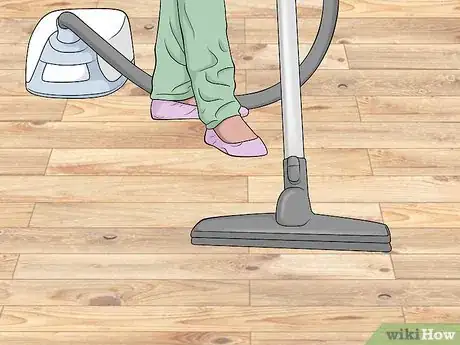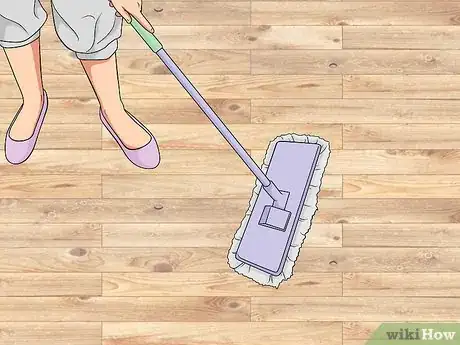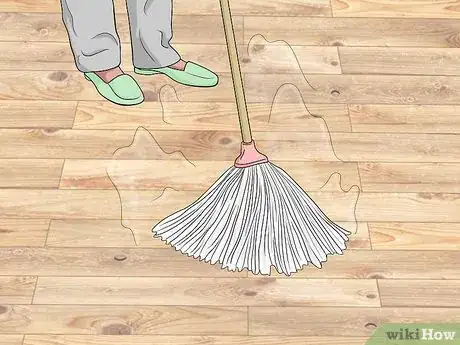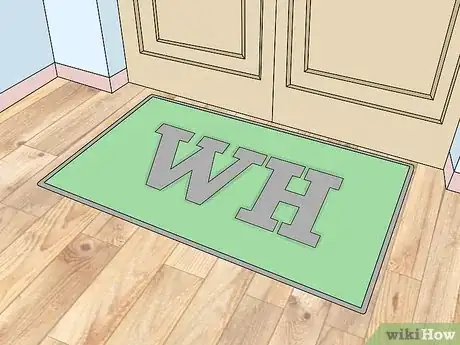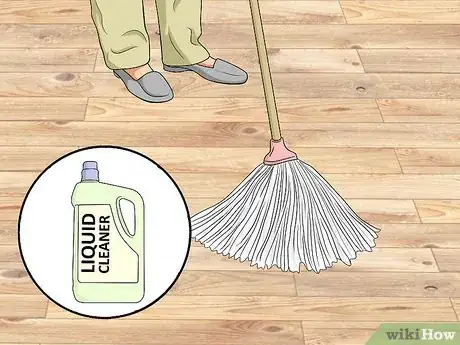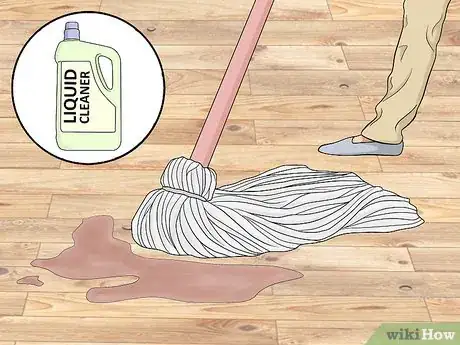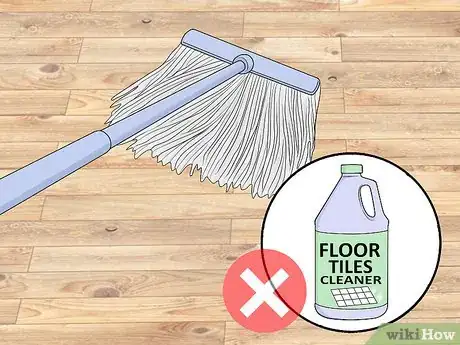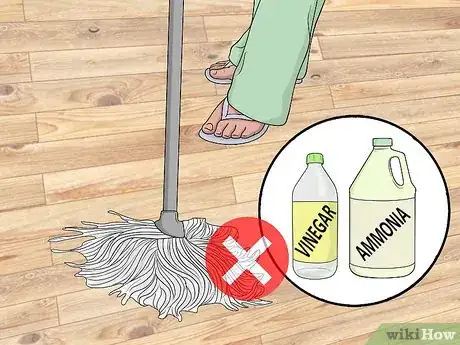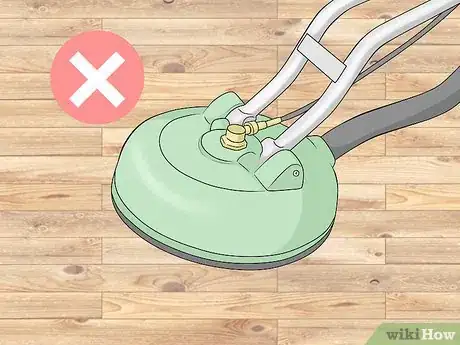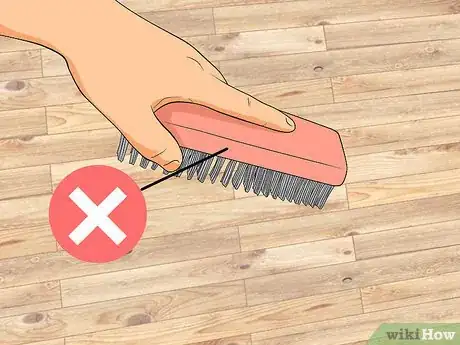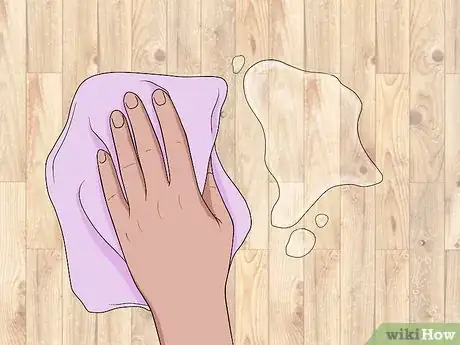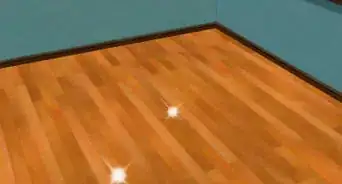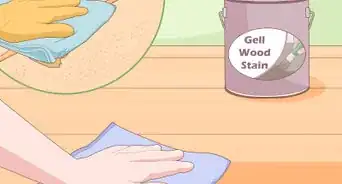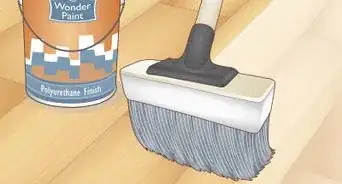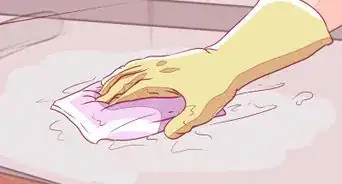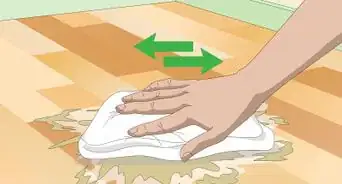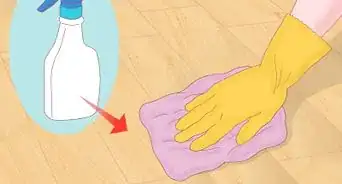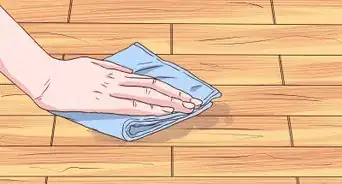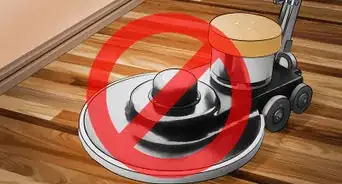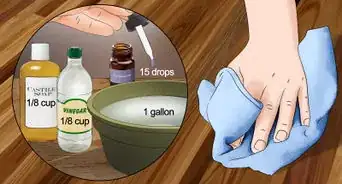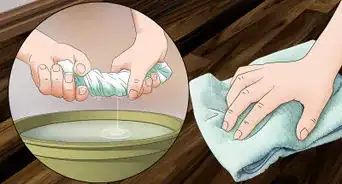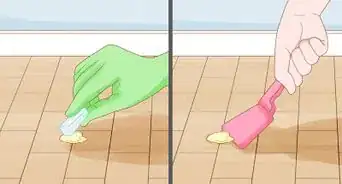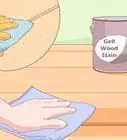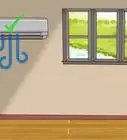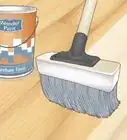This article was co-authored by Ashley Matuska. Ashley Matuska is a Professional Cleaner at the Founder and Owner of Dashing Maids in Denver, Colorado. Ashley has over seven years of experience in the cleaning industry. She and her team specialize in offering sustainable deep cleaning and maintenance cleaning services.
wikiHow marks an article as reader-approved once it receives enough positive feedback. In this case, 80% of readers who voted found the article helpful, earning it our reader-approved status.
This article has been viewed 198,385 times.
An engineered hardwood floor—as opposed to a traditional hardwood floor, made of only wood—comprises several layers. While the surface of the engineered hardwood is genuine hardwood, the underlying layers are typically made of plywood or high-density fiberboard.[1] To prevent an engineered hardwood floor from being permanently scuffed or stained, you’ll need to clean it regularly. You can begin with a dustpan and broom, and then step up to manufacturer-recommended liquid cleaners.
Steps
Cleaning Up Dirt and Debris
-
1Sweep daily with a broom. Loose pieces of dirt and small stones may be tracked into your house on a daily basis. Use a soft-bristled broom to sweep up all of the dirt in your house. Pay special attention to areas that are more likely to have collected dirt or rocks, such as the entryway. Sweep the dirt and dust into a dustpan, and dispose of it outside.[2]
- If left on the engineered hardwood floor, these will be ground into its surface and can scuff or damage the top layer of hardwood. If left on the floor, dirt and rocks can also scratch the veneer on top of the hardwood flooring.
- To keep your engineered hardwood in good shape, clean them frequently. To maximize the floor’s durability, aim to sweep or vacuum the floors daily.[3]
-
2Vacuum the floor gently. If you’d prefer not to use a broom—or want to make doubly sure that you’ve cleaned up all dirt from the hardwood—you can use a vacuum cleaner on the floor. Make sure to set the cleaner on the “hard floor” mode. This will disable the rotating bristle bar. If left engaged, the rotating bristle bar will scratch and scuff the veneer surface of your floor.[4]
- If you scratch your engineered hardwood floor with a bristle bar, the damage may be irreversible.
Advertisement -
3Mop your hardwood with a dry microfiber mop. Use a microfiber mop to clean the floor and ensure that you’ve cleaned up all dust that’s been tracked or blown into your house. A dry microfiber mop head will effectively pick up any dirt and debris on the floor—including some that your broom may have missed—and you won’t risk damaging your floor with water. Mop your hardwood flooring at least once a week. [5]
- Plan to only mop your engineered hardwood with a microfiber mop. This material will be less abrasive on the veneer and top layer of your hardwood floor than the head of a regular mop would be, and you won’t need to use any water.
-
4Mop your floor with a slightly damp mop. You may not have, or prefer not to use, a microfiber mop. In this case, you can use a traditional yarn mop to clean your floor. Wring out water from your mop thoroughly before you apply the mop to the hardwood. If excess water remains on the hardwood flooring after you’ve mopped, clean this up with a towel.[6]
- A slightly damp yarn mop can also remove any light stains from liquids that may have spilled on the floor.
-
5Place a rug at entrances to your house. You can save yourself some work sweeping and mopping your hardwood floors if you protect the entrances to your house—especially the front and back doors—with a rug. A rug will catch much of the dirt, dust, and grime that would otherwise be tracked on your hardwood flooring.
- Try placing one rug outside each entrance, for visitors to wipe any dirt or mud off of their feet. Then, another rug placed inside the doorway will let visitors wipe their feet again, this time removing finer dirt or dust.
- Shake your rug outside weekly, to prevent dust from the rug itself being tracked through the rest of the house.
Using a Liquid Cleaner
-
1Purchase a manufacturer-recommended liquid cleaner. Engineered hardwood floors should only be cleaned with a liquid cleaner that has been manufactured by the company that made the floor. Different types of engineered hardwood require different cleaners, and using the wrong type or brand of liquid cleaner could result in serious damage to your hardwood. If you’re not sure which type of cleaner to use, contact the manufacturer by phone or email to request a liquid-cleaner recommendation.
- You can purchase liquid cleaning products designed for engineered hardwood floors at your local hardware store.
- If a local hardware store does not have them, check the “Cleaning” or “Flooring” section or a larger some supply store, such as Lowe’s or Home Depot.
-
2Scrub spills and stains with the liquid cleaner. If a section of flooring is particularly dirty, or if it has been stained or had liquid spilled on it, you can clean up with the liquid cleaner. Apply a small amount of liquid cleaner directly to the surface of the hardwood, and clean with a sponge mop or a clean cloth. Wipe the hardwood surface until the stain has been removed, adding more cleaner as needed.[7]
- Don’t leave excess liquid cleaner on the floor after you’ve cleaned a stain. Wipe it up immediately with a clean paper towel or cloth. It’s not necessary to rinse the cleaner off using water.
- To clean small spaces that a mop cannot reach, or to wipe up hard-to-reach stains, you may need to scrub by hand. Pour a small amount of liquid cleaner onto a clean cotton cloth, and dab or wipe gently at the dirty area of your floor.
- Some liquid cleaners need to be diluted with water.[8] Make sure you check the instructions on your cleaner before using it.
-
3Do not use cleaning products designed for tile or vinyl flooring. Although the cleaning products themselves may look the same and may even be located next to one another on the shelves at a hardware store, the products are not interchangeable. Liquids that clean tile or vinyl may permanently damage engineered hardwood.[9]
- Cleaning products for tile or vinyl will also not fully clean your engineered hardwood floor. If you have questions about substituting cleaning products, contact the floor manufacturer and ask which liquid cleaning products may be safely used on their floors.
Avoiding Floor Damage
-
1Wipe up any spills immediately. Accidents happen, but if you’ve spilled water—or any other type of liquid—on your engineered hardwood floor, it should be cleaned up immediately. If you allow a liquid spill to sit on hardwood for any length of time, it could soak in and damage the hardwood or the veneer. This could also cause a permanent stain.[10]
- When you’re cleaning up spills, blot gently at the spills to wipe them up. Do not scrub at the spills, or use forceful pressure to clean the area. If you do, you’ll risk warping the hardwood veneer or pressing liquid down into the wood and causing damage.
-
2Avoid vinegar and ammonia. While these abrasive liquids will clean certain surfaces, they will likely damage your engineered hardwood floor. Ammonia and vinegar could erode or mar the veneer surface on top of the upper layer of hardwood.[11]
-
3Never use a steam cleaner on your engineered hardwood floor. While a steam cleaner can be a useful tool for cleaning a carpet floor, it should never be used on engineered hardwood. The steam can damage the wood surface by forcing water into the veneer and the top layer of hardwood.[12]
- A steam cleaner can potentially cause more damage to the hardwood than other forms of cleaning that use excess water (such as an overly wet mop). Since a steam cleaner will force moisture down into the wood, it may damage lower layers of plywood or fiberboard.
-
4Never use an abrasive cleaning brush. Tough, abrasive cleaning products—such as steel wool or a wire-bristle cleaning brush—should never be used on a hardwood floor. These products will almost certainly scratch or otherwise damage the veneer on top of the hardwood.[13]
-
5Wipe up any liquid residue immediately. Although engineered hardwood floors are more resistant to liquids than traditional hardwood floors, you should still never leave water or any liquid cleaner standing on your floor. Dry the floor with a towel if excess liquid cleaner remains after you’ve finished cleaning the floor.
Expert Q&A
Did you know you can get expert answers for this article?
Unlock expert answers by supporting wikiHow
-
QuestionCan you damp mop engineered wood floors?
 Ashley MatuskaAshley Matuska is a Professional Cleaner at the Founder and Owner of Dashing Maids in Denver, Colorado. Ashley has over seven years of experience in the cleaning industry. She and her team specialize in offering sustainable deep cleaning and maintenance cleaning services.
Ashley MatuskaAshley Matuska is a Professional Cleaner at the Founder and Owner of Dashing Maids in Denver, Colorado. Ashley has over seven years of experience in the cleaning industry. She and her team specialize in offering sustainable deep cleaning and maintenance cleaning services.
Professional Cleaner
-
QuestionHow do I clean an engineered wood floor without getting streaks on it?
 Community AnswerTowel-dry the area as you go. It's the last job my tea towels do before they hit the laundry bin.
Community AnswerTowel-dry the area as you go. It's the last job my tea towels do before they hit the laundry bin. -
QuestionCan I use Windex cleaner on hardwood floors?
 Community AnswerWindex is ammonia-based, and the article says not to use ammonia. So I wouldn't recommend it.
Community AnswerWindex is ammonia-based, and the article says not to use ammonia. So I wouldn't recommend it.
References
- ↑ http://www.homeadvisor.com/r/engineered-hardwood-flooring/#.WNKTpfnyvIU
- ↑ http://www.homeflooringpros.com/engineered-floors/maintenance-care-cleaning/
- ↑ https://blog.servicemasterclean.com/residential-clean/how-to-clean-maintain-engineered-hardwood-floors/
- ↑ http://www.homeflooringpros.com/engineered-floors/maintenance-care-cleaning/
- ↑ http://www.homeflooringpros.com/engineered-floors/maintenance-care-cleaning/
- ↑ http://www.homeflooringpros.com/engineered-floors/maintenance-care-cleaning/
- ↑ http://www.bruce.com/cleaning-hardwood-flooring.html
- ↑ Ashley Matuska. Professional Cleaner. Expert Interview. 15 April 2019.
- ↑ http://www.homeflooringpros.com/engineered-floors/maintenance-care-cleaning/
- ↑ https://blog.servicemasterclean.com/residential-clean/how-to-clean-maintain-engineered-hardwood-floors/
- ↑ http://www.homeflooringpros.com/engineered-floors/maintenance-care-cleaning/
- ↑ http://www.homeflooringpros.com/engineered-floors/maintenance-care-cleaning/
- ↑ https://blog.servicemasterclean.com/residential-clean/how-to-clean-maintain-engineered-hardwood-floors/
- ↑ Ashley Matuska. Professional Cleaner. Expert Interview. 15 April 2019.
- ↑ https://blog.servicemasterclean.com/residential-clean/how-to-clean-maintain-engineered-hardwood-floors/
About This Article
To clean engineered hardwood floors, sweep them daily with a broom or dust mop so you can pick up any dirt that's been tracked in. If you prefer, you can vacuum your floors on the "hard wood" setting. To mop your floors, use a slightly damp dry mop or yarn mop with the flooring manufacturer's recommended liquid cleaner. Make sure to wipe up any excess liquid with a towel after mopping. Don't use ammonia, vinegar, or steam to clean your floors because these can all cause damage. For tips on keeping your floors clean without having to mop, read on!
